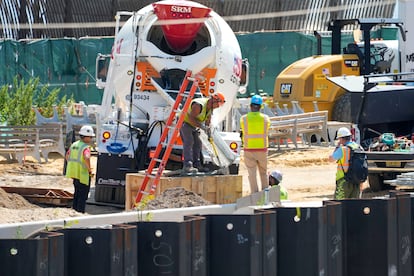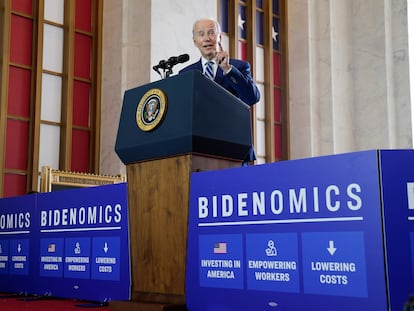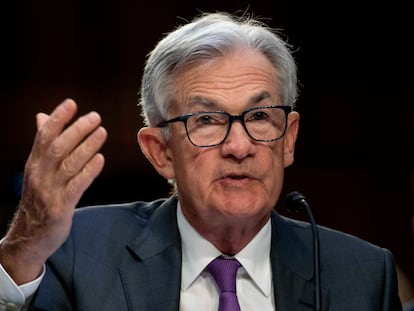The U.S. created 209,000 jobs in June and its unemployment rate fell to 3.6%
Job strength puts pressure on the Federal Reserve to raise rates this month to the highest levels since 2001


The world’s largest economy has been creating jobs each month for two and a half years. That period of recovery since the pandemic crisis coincides with Joe Biden’s time as president. In those two and a half years, over 13 million jobs have been created, a record number. According to data released on Friday by the Bureau of Labor Statistics, in June, 209,000 jobs were added to that total. The unemployment rate stood at 3.6%, also near the half-century low of 3.4%, which was reached in April.
Job creation is the lowest in two and a half years and slowing somewhat more than expected, but it is still very robust. Economists had expected 230,000 jobs and an unemployment rate of 3.6%, according to data compiled by Bloomberg, so the figure is somewhat weaker than anticipated. May’s figure has been revised downward, from the 339,000 jobs initially announced to 309,000, and April’s number has been reduced from 294,000 to 217,000 new jobs.
There have been fears of a recession for over a year now, but there are still jobs to be had, and stories about how hard it is to get an employee are more common than ones about how much it costs to find a job. Still, a significant number of economists continue to anticipate a recession at the end of this year and early next year. “I’ve been hearing every month that there’s going to be a recession next month,” Biden said last week. “I don’t think there will be,” he added. The soft-landing thesis that an economic slowdown is sufficient to tame inflation without entering a recession is gaining some traction.
The strength of the labor market has defied the interest rate hikes by the Federal Reserve, which has raised the price of money by five points since March 2022, to the 5%-5.25% rates it set in May. The full effect of tightening monetary policy is always somewhat delayed, but the U.S. labor market hasn’t reflected it. Similarly, the banking storm in March, which raised fears of a blow to the economy, has not influenced employment either.
The minutes from the last meeting of the Fed’s monetary policy committee show that some of the participants did not even want to take the June pause in rate hikes and that almost all of them were determined to extend the cycle of raising rates somewhat further after that interruption. The central bank’s next interest rate meeting will take place on the 25th and 26th of this month, and experts expect a 0.25 percentage point hike to put rates at 5.25%-5.50%, their highest level since January 2001, when Alan Greenspan was chairman. Interest rates on two-year debt are already at their highest levels since 2007, before the Great Recession.
Public and healthcare employment
Government employment (+60,000) and health care (+41,000) employment were the major drivers of hiring trends in June, followed by social assistance (+24,000), construction (+23,000), and professional and business services (+21,000). Employment took a hit in retail trade (-11,000), building materials and landscaping equipment and supplies dealers (-10,000), and furniture, housewares, electronics and appliance retailers (-5,000).
In June, the average hourly wage for nonfarm private sector wage earners increased by 12 cents, or 0.4%, to $33.58. Over the past 12 months, the average hourly wage has increased 4.4%.
In the United States, the labor market is measured primarily by two surveys: one of companies and the other of households. The first is taken as the main reference for the job creation figure and the second is used to measure the labor force (166.95 million in June) and the unemployed (5.96 million), which makes it possible to calculate the unemployment rate. Normally, the results of the two surveys align with each other, but there are some months when the figures differ significantly.
Welcome news for Biden
The U.S. president wanted to take advantage of the data to boast about it. Citizens do not fully appreciate Biden’s administration, and he is trying to showcase the achievements of his economic policy. “This is Bidenomics in action: Our economy added more than 200,000 jobs last month—for a total of 13.2 million jobs since I took office,” he said in a White House press release. “That’s more jobs added in two and a half years than any president has ever created in a four-year term. The unemployment rate has now remained below 4 percent for 17 months in a row—the longest stretch since the 1960s. The share of working-age Americans who have jobs is at the highest level in over 20 years. Inflation has come down by more than half. We are seeing stable and steady growth. That’s Bidenomics—growing the economy by creating jobs, lowering costs for hardworking families, and making smart investments in America,” he added.
Sign up for our weekly newsletter to get more English-language news coverage from EL PAÍS USA Edition
Tu suscripción se está usando en otro dispositivo
¿Quieres añadir otro usuario a tu suscripción?
Si continúas leyendo en este dispositivo, no se podrá leer en el otro.
FlechaTu suscripción se está usando en otro dispositivo y solo puedes acceder a EL PAÍS desde un dispositivo a la vez.
Si quieres compartir tu cuenta, cambia tu suscripción a la modalidad Premium, así podrás añadir otro usuario. Cada uno accederá con su propia cuenta de email, lo que os permitirá personalizar vuestra experiencia en EL PAÍS.
¿Tienes una suscripción de empresa? Accede aquí para contratar más cuentas.
En el caso de no saber quién está usando tu cuenta, te recomendamos cambiar tu contraseña aquí.
Si decides continuar compartiendo tu cuenta, este mensaje se mostrará en tu dispositivo y en el de la otra persona que está usando tu cuenta de forma indefinida, afectando a tu experiencia de lectura. Puedes consultar aquí los términos y condiciones de la suscripción digital.
More information
Archived In
Últimas noticias
Most viewed
- Sinaloa Cartel war is taking its toll on Los Chapitos
- Oona Chaplin: ‘I told James Cameron that I was living in a treehouse and starting a permaculture project with a friend’
- Reinhard Genzel, Nobel laureate in physics: ‘One-minute videos will never give you the truth’
- Why the price of coffee has skyrocketed: from Brazilian plantations to specialty coffee houses
- Silver prices are going crazy: This is what’s fueling the rally










































